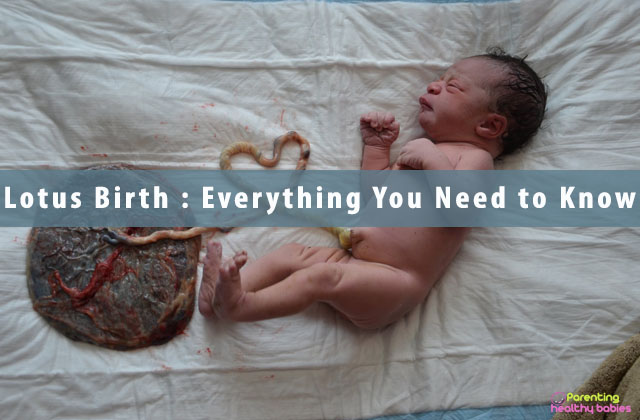When parents Elie and Justin gave birth to their newborn son, Joey, they decided to not to cut the umbilical cord. This was different and complete natural birth at home and opted for lotus birth.
Umbilical cod and placenta have special relationship with the baby and is wrapped around them.
Lotus birth is the practice of leaving the umbilical cord attached to the placenta and baby until it fails off naturally, usually within 3 to 10 days of birth. Also known as umbilical non-severance. It is a recent birth practice and not many people have heard of it. Yet it is becoming popular among mothers and they chose lotus birth for their babies, believing it is a natural and gentle transition from womb to world. It had only been observed in chimpanzees and later became popular in the 1970’s. The implications of it are best approached through the perspective of the ancient mystery traditions developed in places as diverse as India, China and Egypt.The practice is performed mainly for spiritual purposes.
Lotus Birth: Meet Your New Baby
Lotus birth is not chosen by everyone but yes it offers some benefit to mother and baby. It ensures all the benefits of Delayed Cord Clamping (DCC) (waiting a few minutes after birth to cut the cord instead of cutting it right away) for the newborn baby. Studies have shown that waiting just a few minutes ensures that all of the placental blood, which is rich in iron and stem cells, is transferred to the baby.
Why people consider lotus birth ? What are its benefits ?
here are some reasons
- After recovering from birth of baby, the mother is more likely to rest and to stay with their baby which allow parent and baby to adjust with each other.
- As a part of you stays attached to your baby, which can enhance the bonding process between mother and baby.
- As the umbilical cord is left so the baby receives all of the placental blood.
- The pocess and practice honours the connection the baby had with the placenta that has nourished for nine months and values the trasition stage between womb and world.
- It allows transfer of an extra 100ml of blood from placenta to baby, around 1/3 of total newborn blood volume. By this blood babies are less likely to suffer from anaemia in the first year of life as compared to the babies whose cord is cut down.
- It also gives extra blood for heart and brain to the babies which keep them healthy.
- As mother and baby have more time to contact so it gives the baby healthy glucose levels, less crying, more organized behaviour, more quiet sleep and better temperature regulation.
- In delayed cord clamping, lotus birth does not disrupt blood volume and allows the oxygenated blood to flow back into the baby. The improves blood circulation, body temperature, red blood cell count, immune system and brain development.
- As this is natural process so there’s no wound created at the umbilical site.
- It makes your birthing experience more natural, and it is considered safe for you and your baby.
- There’s less disruption to your baby’s blood volume as it allows a complete transfer of placental blood to the baby.
Therefore, it extends the birth time and enables baby, mother and father and all family members to feel, capture and enjoy the moment.
After the birth of baby, the umbilical cord is left intact and waiting for the appearance of the placenta. When the placenta is seen, it is placed in bowl and waiting for the cord to completely stop pulsating. By this the remaining blood in the placenta is transfused to the baby which has many benefits.
How can the care for placenta be taken?
- Leave the umbilical cord intact after the baby is born. If the cord is around the baby’s neck, lift it over gently.
- Natural delivery of placenta should be done. Do not use oxytocin because it forces too much and too soon into the infant and compromises the placenta delivery.
- After the delivery of placenta, place it into bowl beside the mother.
- Before handling the placenta wait for full transfusion of the umbilical blood into the baby.
- Gently wash the placenta with warm water and pat dry.
- Wrap it in any absorbent material like a cloth and then put it into a placenta bag. Also the placenta may be laid on a bed of sea salt which should be changed daily and liberally covered with salt.
- The baby is held and fed as the mother wishes to.
- Then the baby is clothed loosely.
Lotus Birth establishes the baby placenta relationship. It ensures that the body is well cared for by ensuring that the baby receives the full oxygen bearing highly nutritious blood that is in the umblical cord. By this the infant gets 40 to 60 ml of extra blood from the placenta if the cord is not tired until pulsations cease. The loss of 30 ml of blood to the newborn is equivalent to the loss of 600 ml to an adult.
In 2008 The Royal College of Obstetricians and Gynaecologists has warned about the risks of infection of this leaving the placenta attached which consequently spread to the baby. The placenta is particularly prone to infection as it contains blood. Other risks include jauncide and polycythemia. Therefore, no evidence exists to support any medical benefits for the baby through this.
One of the biggest risks is the possibility of infection. Parents who choose a lotus birth should monitor their babies more closely for infection. Because the placenta holds lots of protein and other compounds after birth, there are bacterial overgrowth risks if not properly cared for. If there is any foul odor, unusual color or any indication of a problem, then should be taken to the doctor. Other than infections there are some other points for placenta which should be kept in mind-
- Placenta should be placed in a colander to dry for 24 hours as it takes too long to dry after birth.
- Placenta can decay and decompose it not taken care properly.
- Keeping both placenta and umbilical cord clean.
- It should be placed in a special bag until it falls off.
Conclusion
Lotus birth is the practice of leaving the umbilical cord attached to the placenta and baby until it dries up and falls off naturally, usually taking between three to ten days before completely detaching from baby’s navel. Because of this the mother and baby stay together which enhance bond between them.The main purpose of a lotus birth is to allow the baby to obtain all the nutrients the placenta has to offer, such as stem cells and recover blood, before the placenta dries up. Major risk is it leads to infection.













